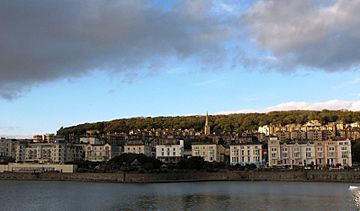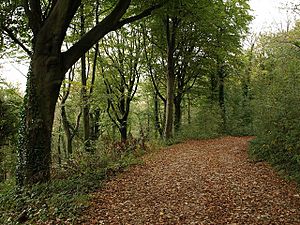Worlebury Hill facts for kids
Quick facts for kids Worlebury Hill |
|
|---|---|

The western end of the hill viewed from the south across Marine Lake
|
|
| Highest point | |
| Geography | |
| Location | North Somerset, England |
| Parent range | Weston-Worle Ridge |
| Geology | |
| Mountain type | hill |
Worlebury Hill is a special upland area in North Somerset, England. It sits between the flat lands of Weston-super-Mare and the Kewstoke area.
This hill starts at sea level and rises to 109 meters (about 358 feet) at its highest point. The western part of the hill sticks out like a finger into the Bristol Channel. It lies between Weston Bay and Sand Bay.
A road goes around the coast of the hill. It runs from Sand Bay in the north to the old Birnbeck Pier in the west. You can also find the Worlebury Golf Club on the hill. Many large, old houses from the Victorian era are built on the lower slopes of the hill.
History of Worlebury Hill
Worlebury Hill is home to an ancient Iron Age hillfort called Worlebury Camp. This fort is located at the western end of the hill's wooded ridge. It was built with strong stone walls.
People dug up parts of the fort in the 1800s. They found details about storage pits and the old walls. This site is very important, so it is a Scheduled monument. This means it is protected by law. However, it needs some care to keep it from falling apart.
In the past, before the flat lands were drained, the main road to Bristol went along the hillside. People also used to dig for stone in different parts of the hill. This quarrying happened from the late 1700s until 1953.
Weston Woods and Nature
Weston Woods covers a large part of Worlebury Hill. These woods are a special place for nature. They have even won an award for being a great example of a green space in a town. The woods are also a local nature reserve, which means they are protected for wildlife.
The woods are home to many animals. You might see deer, badgers, foxes, and bats living there. Many different birds also call the woods home. These include woodpeckers, buzzards, and treecreepers.
In 2020, the local council started looking at ways to protect the old Iron Age fort. This might involve carefully removing some trees to help save the ancient remains.



